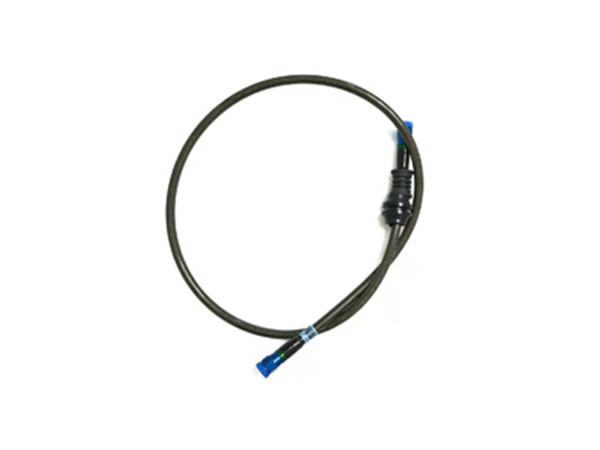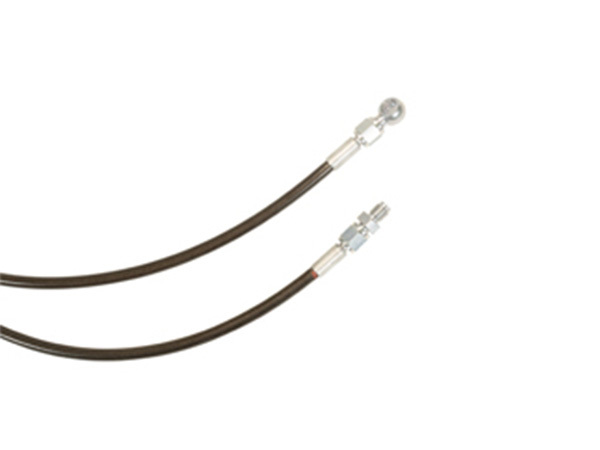Comparing Different Types of Brake Tubing for Motorcycle Tricycles: Choosing the Best Option for Safety and Performance
2025-10-10
Comparing Different Types of Brake Tubing for Motorcycle Tricycles
Motorcycle tricycles provide a unique blend of stability and maneuverability, making them a popular choice among riders. However, the safety and performance of these vehicles heavily depend on the quality of their braking systems. One of the critical components of a robust brake system is the brake tubing, which plays a pivotal role in delivering hydraulic pressure to the brakes. In this article, we will explore the different types of brake tubing available for motorcycle tricycles, their features, benefits, and how to choose the best option for your needs.
Table of Contents
1. Introduction to Brake Tubing
2. Why Brake Tubing Matters for Motorcycle Tricycles
3. Types of Brake Tubing for Motorcycle Tricycles
- 3.1 Rubber Brake Tubing
- 3.2 Steel Brake Tubing
- 3.3 Braided Stainless Steel Brake Tubing
- 3.4 Nylon Brake Tubing
- 3.5 Custom Brake Tubing Solutions
4. Comparing Brake Tubing Options: Performance and Safety
5. Installing Brake Tubing: What You Need to Know
6. Maintaining Your Brake System for Longevity
7. Frequently Asked Questions (FAQs)
8. Conclusion
Introduction to Brake Tubing
Brake tubing is an essential part of the braking system in any motorcycle tricycle. It is responsible for transmitting hydraulic pressure from the master cylinder to the brake calipers, allowing the vehicle to stop effectively. Inadequate or faulty brake tubing can lead to brake failure, posing significant safety risks. Therefore, understanding the different types of brake tubing available is crucial for selecting the right one that meets your performance and safety requirements.
Why Brake Tubing Matters for Motorcycle Tricycles
The significance of choosing the right brake tubing cannot be overstated. Brake tubing affects not only the performance of the braking system but also the overall safety of the rider. The wrong type of tubing can lead to brake fluid leaks, diminished braking power, and ultimately, catastrophic failure. Riders must consider factors such as material durability, temperature resistance, and flexibility when selecting brake tubing to enhance their motorcycle tricycle's performance and safety.
Types of Brake Tubing for Motorcycle Tricycles
Understanding the various types of brake tubing available for motorcycle tricycles is vital in making a well-informed decision. Each type has its advantages and disadvantages, which we will explore in detail below.
Rubber Brake Tubing
Rubber brake tubing has been the traditional choice for many years. It offers a balance of flexibility and performance, making it easy to install and fit into various configurations. Rubber tubing can withstand a wide range of temperatures, making it suitable for most riding conditions. However, it can deteriorate over time due to exposure to heat, moisture, and road debris.
**Key Advantages of Rubber Brake Tubing:**
- Cost-effective
- Easy to install
- Suitable for various applications
**Disadvantages:**
- Limited lifespan
- Susceptible to wear and tear
Steel Brake Tubing
Steel brake tubing is a robust alternative to rubber. It’s known for its durability and resistance to kinks and impacts. Steel tubing is less flexible than rubber, which can make installation more challenging. On the plus side, steel brake tubing can handle higher pressures, making it ideal for performance-oriented motorcycle tricycles.
**Key Advantages of Steel Brake Tubing:**
- High pressure resistance
- Exceptional durability
- Less prone to damage
**Disadvantages:**
- More rigid, which can complicate installation
- Heavier than other options
Braided Stainless Steel Brake Tubing
Braided stainless steel brake tubing is a premium option that combines the best features of rubber and steel. The inner layer is made of rubber, while the outer layer consists of braided stainless steel. This design provides excellent pressure resistance and minimizes the chances of expansion under high pressure, ensuring a more responsive braking experience.
**Key Advantages of Braided Stainless Steel Brake Tubing:**
- Superior braking performance
- Reduced risk of expansion
- Corrosion-resistant
**Disadvantages:**
- Higher cost
- More complex installation process
Nylon Brake Tubing
Nylon brake tubing is lightweight and flexible, making it an attractive option for motorcycle tricycles. It is resistant to abrasions and can withstand a range of temperatures. However, nylon tubing is not as pressure-resistant as rubber or steel options, making it less suitable for high-performance applications.
**Key Advantages of Nylon Brake Tubing:**
- Lightweight
- Flexible and easy to install
- Resistant to abrasions
**Disadvantages:**
- Lower pressure resistance
- May not be suitable for all riding conditions
Custom Brake Tubing Solutions
For riders seeking tailored solutions, custom brake tubing can be an excellent option. Manufacturers can create tubing that fits specific measurements and performance requirements, ensuring optimal compatibility and safety. However, custom solutions often come at a premium price and may require longer lead times.
**Key Advantages of Custom Brake Tubing:**
- Tailored solutions for specific needs
- Optimal fit and performance
- Unique designs available
**Disadvantages:**
- Higher cost
- Longer wait times for manufacturing
Comparing Brake Tubing Options: Performance and Safety
When comparing brake tubing options for motorcycle tricycles, it’s crucial to evaluate the performance and safety of each type. Rubber tubing may be a cost-effective choice but could compromise safety over time. Steel and braided stainless steel options provide more durability and safety, making them ideal for performance riders.
**Performance Factors to Consider:**
- Pressure resistance
- Temperature tolerance
- Flexibility and installation ease
**Safety Considerations:**
- Risk of leaks or failure
- Durability and lifespan
- Brake system compatibility
Ultimately, the choice of brake tubing should align with your riding style and safety priorities.
Installing Brake Tubing: What You Need to Know
Proper installation of brake tubing is critical to ensuring optimal performance. Regardless of the type of tubing chosen, following manufacturer instructions and using the right tools is essential. Here are some key steps to consider when installing brake tubing on your motorcycle tricycle:
- **Preparation:** Gather necessary tools, including wrenches, pipe cutters, and flare tools. Ensure you have the appropriate brake fluid handy.
- **Remove Old Tubing:** Carefully detach the existing brake tubing from the master cylinder and calipers. Inspect for any wear or damage.
- **Measure and Cut:** If using custom or steel tubing, measure the length needed and cut accordingly. Ensure clean, straight cuts for a proper fit.
- **Connect and Secure:** Attach the new tubing to the master cylinder and calipers, ensuring tight seals to prevent leaks.
- **Bleed the Brakes:** After installation, bleed the brake system to remove any air bubbles, ensuring optimal braking performance.
Following these steps will help ensure a safe and efficient installation.
Maintaining Your Brake System for Longevity
To prolong the life of your brake tubing and overall brake system, regular maintenance is essential. Here are some tips to keep your brake system in top condition:
- **Regular Inspections:** Frequently check your brake lines for leaks or wear. Any signs of damage should be addressed immediately.
- **Fluid Checks:** Ensure that brake fluid levels are adequate and that the fluid is clean. Contaminated fluid can lead to brake failure.
- **Keep Components Clean:** Regularly clean components of the braking system to prevent debris buildup, which can affect performance.
- **Replace as Needed:** If you notice any signs of deterioration in the brake tubing, replace it promptly to maintain safety.
Adhering to a maintenance schedule will ensure your motorcycle tricycle's braking system operates smoothly and efficiently.
Frequently Asked Questions (FAQs)
**1. What is the best type of brake tubing for motorcycle tricycles?**
The best type of brake tubing depends on your specific needs. For performance, braided stainless steel tubing is ideal. For budget-conscious riders, rubber tubing is a solid choice.
**2. How often should I replace brake tubing?**
Brake tubing should be inspected regularly for wear and tear. Typically, replace it every 2-5 years, depending on the material and usage conditions.
**3. Can I install brake tubing myself?**
Yes, with the right tools and knowledge, you can install brake tubing yourself. However, if you are unsure, it is best to consult a professional mechanic.
**4. How do I know if my brake tubing is damaged?**
Signs of damage include visible cracks, leaks, or a spongy brake feel. If you notice any of these symptoms, inspect or replace the tubing immediately.
**5. Will upgrading to braided stainless steel tubing improve my braking performance?**
Yes, upgrading to braided stainless steel tubing can enhance braking performance by reducing expansion under pressure and increasing responsiveness.
Conclusion
Choosing the right brake tubing for your motorcycle tricycle is a crucial decision that impacts both safety and performance. Each type of brake tubing—rubber, steel, braided stainless steel, nylon, and custom solutions—has unique advantages and disadvantages. By considering factors such as durability, pressure resistance, and installation ease, you can make an informed decision that aligns with your riding style and safety needs.
Regular maintenance and timely replacements will ensure a reliable braking system, enhancing your overall riding experience. Invest in quality brake tubing, and enjoy the peace of mind that comes with knowing your motorcycle tricycle is equipped for safety and performance.
Key words:
Recommended News
Unlocking Performance: The Role of Fisheye Joints in Motorcycle Brake Systems
Unlocking Performance: The Role of Fisheye Joints in Motorcycle Brake Systems
Table of Contents
1. Introduction to Fisheye Joints in Motorcycle Brake Systems
2. Understanding Fisheye Joints: Definition and Purpose
3. Importance of Effective Braking Systems in Motorcycles
4. How Fisheye Joints Work in Brake Systems
5. Advantages of Fisheye Joints in Motorcycle Brake Performan





